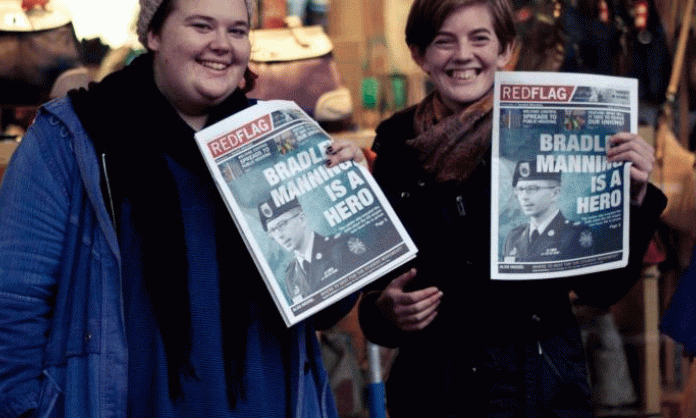Red Flag builds on a long tradition of socialist publications. Russian revolutionary Vladimir Lenin drummed into his supporters in “Where to Begin?”, written in 1901, the role of the newspaper as “scaffolding” in building an organisation:
“The role of a newspaper … is not limited solely to the dissemination of ideas, to political education, and to the enlistment of political allies. A newspaper is not only a collective propagandist and a collective agitator; it is also a collective organiser. In this last respect it may be likened to the scaffolding round a building under construction, which marks the contours of the structure and facilitates communication between the builders, enabling them to distribute the work and to view the common results achieved by their organised labour.
“With the aid of the newspaper, and through it, a permanent organisation will naturally take shape that will engage, not only in local activities, but in regular general work, and will train its members to follow political events carefully, appraise their significance and their effect on the various strata of the population, and develop effective means for the revolutionary party to influence those events.”
During the ’60s youth radicalisation, I helped produce several publications, and first became involved in publishing a regular socialist paper with the first issue of Direct Action. Launched in Sydney in September 1970, it had a clear purpose, stating in its first editorial:
“To publish a paper without an organisation to build and be built by it is political irresponsibility. It is to play with politics. Only when a paper has an organisation to build, and that organisation has a program to guide it, does a little left wing venture such as ours take on any meaning.”
The editorial reflected our frustration with the old Trotskyist group, which refused to seriously build an organisation. It also reflected our contempt for the intellectual left, which sometimes produced magazines, but no organisation. It was also aimed at campus dilettantes.
Direct Action was published on behalf of the socialist youth organisation Resistance, and it soon became the paper of the Socialist Workers Party (which later changed its name to Democratic Socialist Party).
I edited the first issue and then moved to Melbourne, where we had a few supporters, to sell it at the second Vietnam Moratorium in September 1970. My sales of 430 on the day ensured I was an enthusiastic supporter and seller of the socialist press for the following 43 years! We soon had a branch in Melbourne,
Direct Action had an initial print run of 5000, which increased to 9000 for the following issues. But with the end of the Vietnam War and the decline in the youth radicalisation, sales of the socialist press became a harder grind.
In 1991, to overcome the lagging sales of DA, and to reach out to a broader readership, we changed the paper’s name to Green Left Weekly. It had the desired result – street sales rose, initially by a factor of 2.4 compared to DA.
James P. Cannon, the leader of the US Trotskyists, explained in a letter written from prison in 1944 his view on the role of their newspaper, the Militant, which we benefited from for both DA and GLW:
“The Militant must strive to be a combination paper; a paper which interests and serves the needs of the new reader who picks it up for the first time, the reader who is beginning to think of himself [sic] as a Trotskyist without yet thinking about the party, and the educated party militant – all at the same time.”
A combination paper such as Red Flag needs to report on strikes and struggles against injustice, and carry more weighty theoretical articles, analysing the state of capitalism and the direction of the movement against it. It needs to carry reviews and cultural commentary, letters and discussion, publicise our events, forums etc. and the campaigns we’re involved in. It must introduce readers to the role of the organisation – the political positions, statements; the organising role; the finance campaigns to produce the paper; the efforts of members to sell subscriptions and maximise the sales of single copies on campuses, workplaces, city streets and all left political events.
Red Flag will play a role in reaching-out and building the movement. It will provide new impetus for further unity of the revolutionary left.










